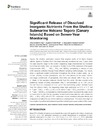Identificador persistente para citar o vincular este elemento:
https://accedacris.ulpgc.es/handle/10553/70325
| Título: | Significant Release of Dissolved Inorganic Nutrients From the Shallow Submarine Volcano Tagoro (Canary Islands) Based on Seven-Year Monitoring | Autores/as: | González Vega, Alba Fraile Nuez,Eugenio Santana-Casiano, J. Magdalena González-Dávila, Melchor Escánez-Pérez, José Gómez-Ballesteros, María Tello, Olvido Arrieta, Jesús M. |
Palabras clave: | Canary Islands Hydrothermal Vents Inorganic Nutrients Nutrient Fluxes Tagoro Submarine Volcano |
Fecha de publicación: | 2020 | Proyectos: | "Volcanic Eruption At El Hierro Island, Sensitivity And Recovery Of The Marine Ecosystem" VULCANO-II (CTM2014-51837-R) BIMBACHE (IEO-2011-2012) RAPROCAN-III (IEO-2010-2012) VULCANA-I (IEO-2015-2017) VULCANA-II (IEO-2018-2020) |
Publicación seriada: | Frontiers in Marine Science | Resumen: | Tagoro, the shallow submarine volcano that erupted south of El Hierro (Canary Islands, Spain) in October 2011, has been intensely monitored for over 7 years, from the early eruptive stage to the current degassing stage characterized by moderate hydrothermal activity. Here, we present a detailed study of the emissions of inorganic macronutrients (NO2– + NO3–, PO4, and Si(OH)4) comprising a dataset of over 3300 samples collected through three different sampling methodologies. Our results show a significant nutrient enrichment throughout the whole studied period, up to 8.8-fold (nitrate), 4.0-fold (phosphate), and 16.3-fold (silicate) in the water column, and larger enrichments of phosphate (10.5-fold) and silicate (325.4-fold), but not of nitrate, in the samples collected directly from the vents. We also provide some preliminary results showing ammonium (NH4+) concentrations up to 1.97 μM in the vent fluids as compared to 0.02 μM in the surrounding waters. Nutrient fluxes from the volcano during the degassing stage were estimated as 3.19 ± 1.17 mol m–2 year–1 (NO2– + NO3–), 0.02 ± 0.01 mol m–2 year–1 (PO4), and 0.60 ± 1.35 mol m–2 year–1 (Si(OH)4), comparable to other important nutrient sources in the region such as fluxes from the NW-African upwelling. Nutrient ratios were affected, with a minimum (NO3– + NO2–):PO4 ratio of 2.36:1; moreover, a linear correlation between silicate and temperature enabled the use of this nutrient as a mixing tracer. This study sheds light on how shallow hydrothermal systems impact the nutrient-poor upper waters of the ocean. | URI: | https://accedacris.ulpgc.es/handle/10553/70325 | ISSN: | 2296-7745 | DOI: | 10.3389/fmars.2019.00829 | Fuente: | Frontiers in Marine Science [ISSN 2296-7745], v. 6, article 829 |
| Colección: | Artículos |
Citas SCOPUSTM
33
actualizado el 08-jun-2025
Citas de WEB OF SCIENCETM
Citations
26
actualizado el 08-jun-2025
Visitas
167
actualizado el 04-may-2024
Descargas
142
actualizado el 04-may-2024
Google ScholarTM
Verifica
Altmetric
Comparte
Exporta metadatos
Los elementos en ULPGC accedaCRIS están protegidos por derechos de autor con todos los derechos reservados, a menos que se indique lo contrario.
